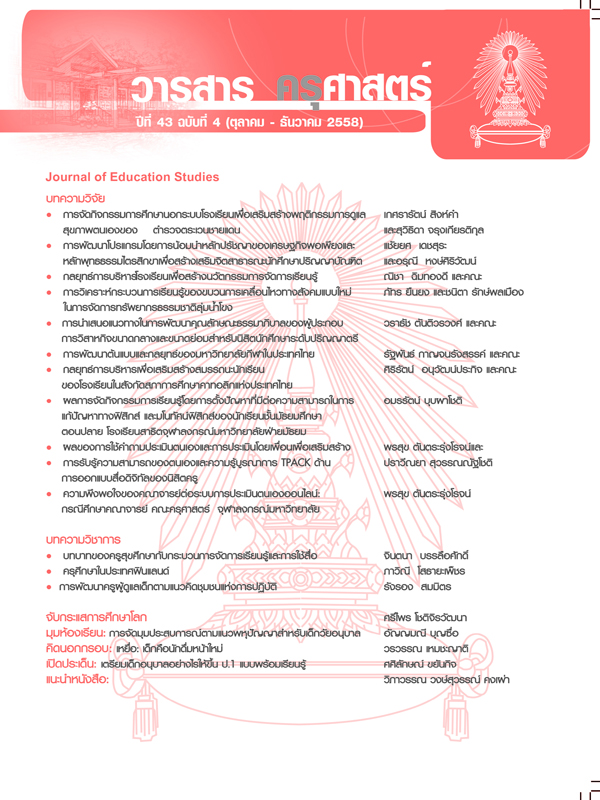กลยุทธ์การบริหารโรงเรียนเพื่อสร้างนวัตกรรมการจัดการเรียนรู้
Keywords:
SCHOOL MANAGEMENT, LEARNING MANAGEMENT, LEARNING MANAGEMENT INNOVATIONS, การบริหารโรงเรียน, การจัดการเรียนรู้, นวัตกรรมการจัดการเรียนรู้Abstract
การวิจัยนี้มีวัตถุประสงค์เพื่อ 1) ศึกษาสภาพปัจจุบัน สภาพที่เป็นไปได้และสภาพที่พึงประสงค์ของการบริหารโรงเรียนเพื่อสร้างนวัตกรรมการจัดการเรียนรู้ 2) วิเคราะห์จุดแข็ง จุดอ่อน โอกาสและภาวะคุกคามของการบริหารโรงเรียนเพื่อสร้างนวัตกรรมการจัดการเรียนรู้ 3) พัฒนากลยุทธ์การบริหารโรงเรียนเพื่อสร้างนวัตกรรมการจัดการเรียนรู้ โดยใช้วิธีวิจัยแบบผสมผสาน กลุ่มตัวอย่าง จำนวน 397 โรงเรียน เครื่องมือ คือ แบบสอบถาม วิเคราะห์ข้อมูลด้วยสถิติบรรยายและเทคนิค PNImodified ผลการวิจัยพบว่า 1) สภาพปัจจุบันของการบริหารโรงเรียนมีค่าเฉลี่ยในระดับปานกลาง สภาพที่เป็นไปได้และสภาพที่พึงประสงค์มีค่าเฉลี่ยอยู่ในระดับมาก 2) จุดแข็ง ได้แก่ การวางแผนกลยุทธ์ การจัดกระบวนการสร้างนวัตกรรมและการเสริมสร้างวัฒนธรรมสร้างสรรค์ จุดอ่อน ได้แก่ การวัดความสามารถขององค์การและการให้รางวัลผู้สร้างนวัตกรรม โอกาส ได้แก่ นโยบายด้านการศึกษาของรัฐและความก้าวหน้าทางเทคโนโลยี ส่วนสภาพเศรษฐกิจและสังคมเป็นภาวะคุกคาม 3) กลยุทธ์หลักการบริหารโรงเรียนเพื่อสร้างนวัตกรรมการจัดการเรียนรู้ ประกอบด้วย (1) เสริมจุดแข็งและโอกาสควบคู่กับการป้องกันภาวะคุกคามในการวางแผนกลยุทธ์เพื่อสร้างนวัตกรรมการจัดการเรียนรู้ (2) เสริมจุดแข็งและโอกาสควบคู่กับการป้องกันภาวะคุกคามในการจัดกระบวนการสร้างนวัตกรรมการจัดการเรียนรู้ (3) เสริมจุดแข็งและโอกาสควบคู่กับการลดจุดอ่อนในการเสริมสร้างวัฒนธรรมสร้างสรรค์ (4) เสริมโอกาสควบคู่กับการลดจุดอ่อนและป้องกันภาวะคุกคามในการวัดความสามารถขององค์การในการสร้างนวัตกรรมการจัดการเรียนรู้ และ (5) เสริมจุดแข็งและโอกาสควบคู่กับการลดจุดอ่อนและป้องกันภาวะคุกคามในการให้รางวัลผู้สร้างนวัตกรรมการจัดการเรียนรู้
The objectives of the research were 1) to study the current, possible and desirable states of school management; 2) to analyze the strengths, weaknesses, opportunities and threats of school management; and 3) to develop school management strategies for creating learning management innovations with mixed method research. The samples were 397 schools. The research instrument consisted of questionnaires. Data were analyzed by descriptive statistic and PNImodified technique. The findings were as folllows: 1) The overall current school management for creating learning management innovations was at a moderate level and the overall possible and desirable school management for creating learning management innovations was at a high level. 2) The strengths were the strategic planning, innovation process and creative culture. The weaknesses were the innovation metrics and innovation rewards. The opportunities were the government education policies and technological advancement. The Threats were the economic and social conditions. 3) The school management strategies for creating learning management innovations were (1) Enrich the strengths and opportunities and prevent threats for creating learning management innovations in strategic planning; (2) Enrich the strengths and opportunities and prevent threats for creating learning management innovations in innovation process; (3) Enrich the strengths and opportunities and decrease weaknesses for creating learning management innovations in creative culture; (4) Enrich the opportunities and decrease weaknesses and threats for creating learning management innovations in innovation metrics; and (5) Enrich the strengths and opportunities and decrease weaknesses and threats for creating learning management innovations in innovation rewards.




